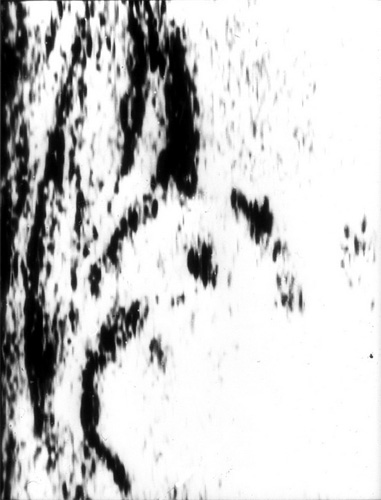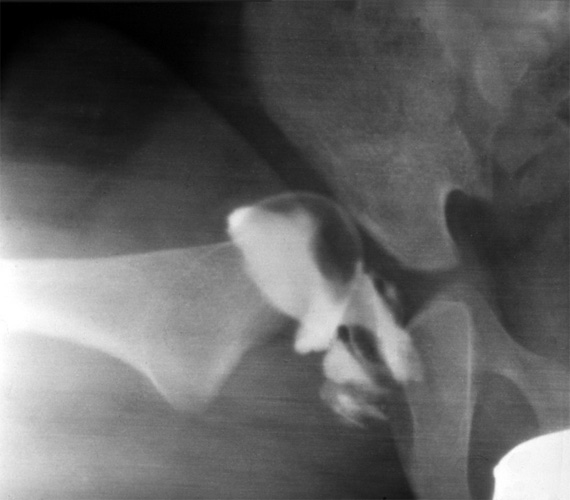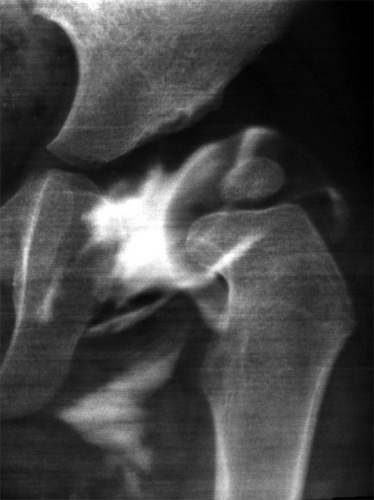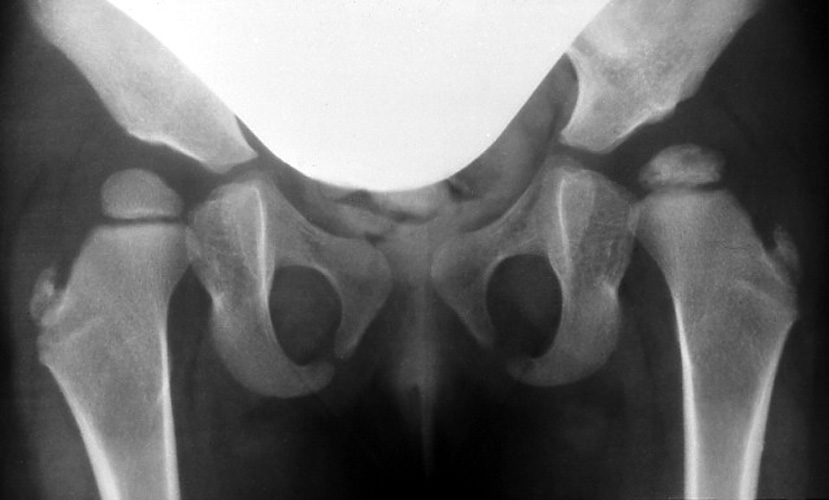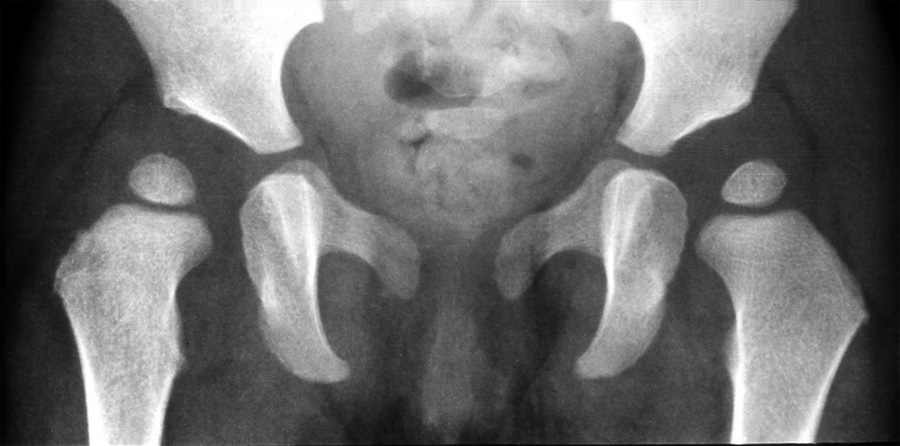
Prof. Dr. med. Dietrich Tönnis
Sammlung wissenschaftlicher Arbeiten und Vorträge zur Orthopädie
Age Iimits in pelvic Osteotomies
© Prof. Dr. med. Dietrich Tönnis
By clicking on a figure an enlarged version of the figure will appear. At the end of the page you will find a PDF version of the paper.
I was asked to give in addition a paper on „Age limits in pelvic osteotomies“. This includes acetabuloplasties and triple pelvic osteotomies, and there are borderlines below and upwards in the age of our children and adults. When we begin with the borderline below in acetabuloplasties, we have to realize that after birth immediately we have to check whether there is a congenital hip dysplasia or dislocation.

In the first year of life dysplasias are treated by splints and abduction pillows and dislocations of the hip get a plaster cast in squatting position, which is most effective (Fig. 1).

But we have to check whether the femoral heads nucleus is present already (Fig. 2). If not, osteonecrosis of the femoral head will develop, when the entrance of the joint is too narrow, or filled up, and the femoral head has to mold its way into the acetabular bottom.
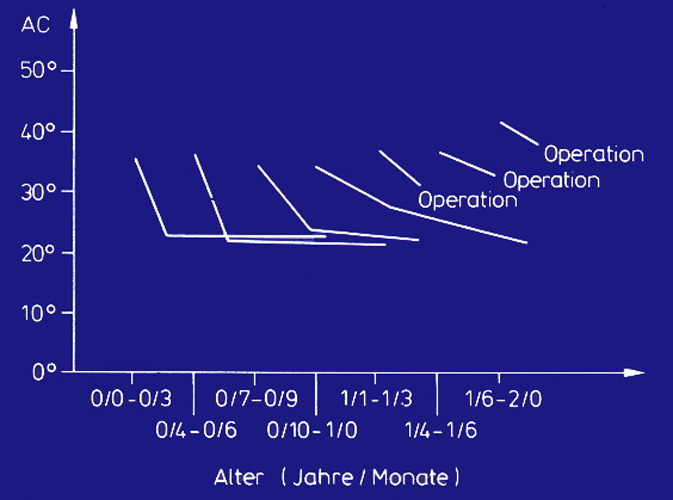 And now I want to present you a picture of the improvement of the acetabular angle during plaster cast in squatting position (Fig. 7). Hips treated early in the first year of life are normalized immediately, and joints coming at the last months of the first year, show a normal angle only if treated up to the age of 1 1/2 years.
And now I want to present you a picture of the improvement of the acetabular angle during plaster cast in squatting position (Fig. 7). Hips treated early in the first year of life are normalized immediately, and joints coming at the last months of the first year, show a normal angle only if treated up to the age of 1 1/2 years.
In the second year you see that the lines of improvement of the acetabular angle do not decrease sufficiently and acetabular osteotomies are necessary.
Our earliest acetabuloplasties have been performed at the end of the first year of life in a few patients, otherwise in the second year of life and later.
 After the first year we should look whether the joints are unstable at movements and in arthrographies and have a higher angle of the acetabulum and dislocation. Unstable joints do not improve spontaneously (Fig. 10).
After the first year we should look whether the joints are unstable at movements and in arthrographies and have a higher angle of the acetabulum and dislocation. Unstable joints do not improve spontaneously (Fig. 10).
Now we have to discuss, up to what age typical acetabuloplasties can be performed. In the early years we thought, when we bend down the acetabular roof at the end of the osteotomy in the bone, short before the triradiate cartilage, we would bend it too in the cartilage and this would end, when the cartilage is ossifying at the age of 9 to 11 years.
But later we saw that acetabuloplasties are possible up to 12 or 13 years too.
Varus and a few triple osteotomies were also performed sometimes below 10 years when there was a Legg-Calvè-Perthes disease deforming the femoral head.
Now to the question up to what age we perform triple pelvic osteotomies. Before we should mention up to what degrees of osteoarthrosis should we perform these osteotomies. We have defined these degrees in 4 grades (Tab. 1). Of cource it is the best if there is no arthrosis or only of grade 1 and 2. At grade 2 the person should not have to much weight.
| Grade 0 | No signs of osteoarthrosis |
| Grade 1 | Increased sclerosis of femoral head and acetabulum, slight narrowing of joint space, femoral head slightly deformed |
| Grade 2 | Small cysts in femoral head and acetabulum, severe narrowing or loss of joint space, moderate loss of roundness of femoral head |
| Grade 3 | Great cysts, severe loss of roundness of femoral head, loss of joint space |
In young persons one would still try to prevent a total hip and also in people of 40 years and more when they are very active on the legs. Some people still want to wait with a total hip before 50 or more years. But the threaded titanium shell and the cementless titanium stems now are apt to stand long years too.
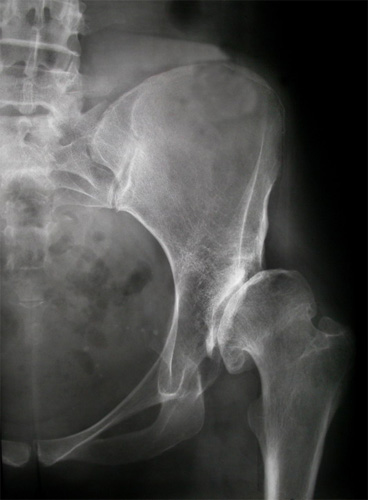
For the friends of total hips I have a picture too (Fig. 13). What would you do in this 42 year old lady?
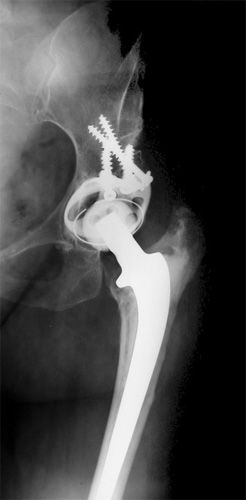
... and then added bone to the acetabular roof and fixed it with several screws (Fig. 15). She is now still free of pain 18 years later.
My final statement is: If there is a dysplasia of the adult hip in younger years, one should perform a triple pelvic osteotomy before osteoarthrosis develops.
| Download | |
|---|---|
| Age Iimits in pelvic Osteotomies | PDF (1.4MB) |
